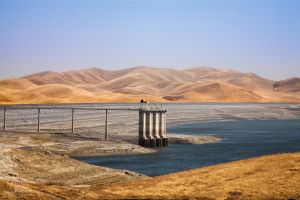By The Editor
An aqueduct in Southern California
Turn on your faucet, and what do you get? Rain that fell on Mount Shasta? Snow from the Feather River watershed in the Sierras? Glacial melt from the Colorado Rockies? Water from deep sandy aquifers far beneath your feet that originated as rainfall on the slopes of the San Gabriels? In Los Angeles and Orange Counties, we drink an exotic blend of waters gathered from near and far. The water that comes from afar is transported by one of the world’s most massive water transfer systems.
California State Water Project
One part of this system is a network of reservoirs, aqueducts, pumping stations, and hydroelectric facilities called the California State Water Project, which distributes water from the Sacramento and Feather River watersheds to the San Francisco Bay Area, the Central Valley, San Luis and Santa Barbara Counties, and Southern California. The California Aqueduct, the component that brings water to Southern California, is 444 miles long; it begins at the southern edge of the Sacramento-San Joaquin Delta, into which Sacramento and Feather River (and other) water is fed, bifurcates once in the Central Valley to send water to the coast, and then bifurcates again south of the Tehachapi Mountains, eventually ending up in Lake Castaic (after spending time in Pyramid Lake) and Lake Perris (after a stay in Silverwood Lake).
Colorado River Aqueduct
The other part of our massive water transfer system brings water from the Colorado River. The Colorado River Aqueduct begins at Lake Havasu and travels 242 miles to Lake Mathews in Riverside County. Its final tunnel bores through the heart of mighty Mt. San Jacinto!
Metropolitan Water District
The agency that oversees the storage, treatment, blending, and final distribution of the water from Northern California and the Colorado River is called the Metropolitan Water District (MWD). It is the largest provider of treated drinking water in the United States. The MWD’s service area extends over 5,200 square miles in Los Angeles, Orange, San Diego, Riverside, San Bernardino, and Ventura counties. Its board comprises representatives from 26 municipalities or smaller water agencies that oversee the final to-the-tap distribution of the imported water (supplemented by local groundwater and recycled water) to approximately 19 million people.
Los Angeles Aqueduct
The City of Los Angeles, while using MWD and local groundwater, has a distant water source all its own: the waters of the Owens Valley and the Mono Basin in the Eastern Sierra Nevada Mountains. This water began flowing through the Los Angeles Aqueduct in 1914 and has been flowing ever since, though now at a reduced volume because of legal rulings that Los Angeles must restore some water to Mono Lake, the Owens River, and Owens Lake.
Other Sources, Other Means
California’s severe drought and its growing population, together with declining supplies from the State Water Project, Owens Valley, and the Colorado River, have forced Southern Californians to seek other sources as well as ways to use water more responsibly and efficiently.
Recycling
Several reclamation plants located in the MWD service area treat sewage effluent to potable standards; this water is used to irrigate landscaping and recharge aquifers.
Desalting
Desalination is fraught with environmental problems and high energy uses, and sometimes raises the knotty issue of water privatization. Several plants are proposed along California’s coast.
Storm Water Capture
The City of Los Angeles and other municipalities plan to capture and store storm water that now runs off to the Pacific Ocean.
Underground Storage
MWD, DWP, and other agencies seek extensive underground storage for water because it averts evaporative loss.
Conservation
Conservation on the part of individuals, commercial businesses, industry, and agriculture is the key to our survival in a future framed by reduced water supply. The water we don’t waste is like a new, unique water source, isn’t it? We didn’t even know it was there because we were sending it straight down the drain or gutter – and now, look, there it is, like an untapped river!
Wouldn’t it be great if, by conserving and recycling, we could rely primarily on local sources? Northern California’s water could flow undiverted through the Sacramento-San Joaquin Delta, restoring it to health. Mono and Owens lakes could fill again, and the Owens River would flow its full length all year long.

